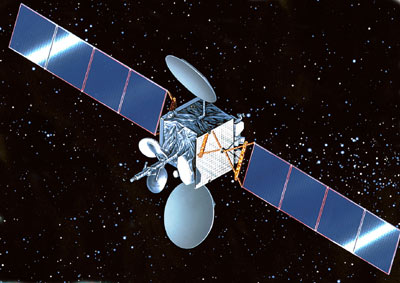PAS 5 → Arabsat 2C → Badr C (Intelsat 5) (original) (raw)

PAS 5 [Boeing BSS]
PanAmSat Corporation ordered its fifth satellite from Hughes Space and Communications Company in March 1995, an enhanced version of the Hughes HS 601 model designated HS-601HP for High Power. At beginning of life, it generates nearly 10 kilowatts. This version takes advantage of such advances as dual-junction gallium arsenide solar cells, new battery technology and the first commercial use of a high-efficiency xenon ion propulsion system (XIPS). These features allow the Hughes HS-601HP to accommodate payloads twice as powerful as those of regular 601 models, while still offering lifetimes as long as 15 years.
PanAmSat became HSC's first customer to launch the new model, on Aug. 28, 1997, on a Russian Proton-K Blok-DM3 rocket from the Baikonur Cosmodrome in Kazakhstan. PAS-5 provides satellite services in the Americas, with access to Europe, including direct-to-home television services in Mexico.
Controllers began noticing degradation of the nickel-hydrogen battery in PAS-5 earlier 1998. The effect on operations was analysed in June 1998. During periods of peak solar eclipse, which occur twice a year, PanAmSat will be required to shut off a portion of the satellite's payload for some time. PanAmSat reportedly received a compensation of US$185 million from its insurers after the satellite was declared a "total loss" because its capacity was reduced by more than 50 percent.
PAS 5 was leased in May 2002 to the Arab Satellite Communications Organisation (Arabsat), which planned to use the spacecraft's C-band transponders to complement its partially defunct Arabsat 3A at 26 degrees East. Intelsat changed the name of the PAS satellites to Intelsat effective to 1 February 2007.
Further PAS missions:
- PAS 1 [AS-3000]
- PAS 1R [HS-702]
- PAS 2, 3, 3R, 4 [HS-601]
- PAS 5 [HS-601HP]
- PAS 6 [SSL-1300]
- PAS 6B [HS-601HP]
- PAS 7 [SSL-1300]
- PAS 8 [SSL-1300]
PAS 9[BSS-702]- PAS 9, 10 [HS-601HP]
- PAS 11 [Star-2]
- PAS 11R [Star-2]
- PAS 12 [SSL-1300]
- PAS 22 [HS-601HP]
Further Intelsat missions:
- Intelsat-1 1 [HS-303]
- Intelsat-2 1, 2, 3, 4 [HS-303A]
- Intelsat-3 1, 2, 3, 4, 5, 6, 7, 8
- Intelsat-4 1, 2, 3, 4, 5, 6, 7, 8 [HS-312]
- Intelsat-4A 1, 2, 3, 4, 5, 6 [HS-353]
- Intelsat-5 1, 2, 3, 4, 5, 6, 7, 8, 9
- Intelsat-5A 10, 11, 12, 13, 14, 15
- Intelsat-6 1, 2, 3, 4, 5 [HS-389]
- Intelsat-7 1, 2, 3, 4, 5, 9 [SSL-1300]
- Intelsat-7A 6, 7, 8 [SSL-1300]
- Intelsat-8 1, 2, 3, 4 [AS-7000]
- Intelsat-8A 5, 6 [AS-7000]
- Intelsat-9 1, 2, 3, 4, 5, 6, 7 [SSL-1300HL]
- Intelsat 10-01 [Eurostar-3000]
- Intelsat 10-02 [Eurostar-3000]
- Intelsat Americas 5, 6, 7 [SSL-1300]
- Intelsat Americas 8 [SSL-1300S]
- Intelsat Americas 9 [SSL-1300]
- Intelsat Americas 13 [SSL-1300]
- Intelsat-APR 1 [Spacebus-3000A]
- Intelsat-APR 2 [I-3K]
- Intelsat-APR 3 [Eurostar-2000+]
- Intelsat K [AS-5000]
- Intelsat K-TV [Eurostar-2000+]
- Intelsat 1R [HS-702]
- Intelsat 1W [Spacebus-4000B2]
- Intelsat 2, 3R, 4 [HS-601]
- Intelsat 5 [HS-601HP]
- Intelsat 6B [HS-601HP]
- Intelsat 7 [SSL-1300]
- Intelsat 8 [SSL-1300]
- Intelsat 9, 10 [HS-601HP]
- Intelsat 11 [Star-2]
- Intelsat 12 [SSL-1300]
- Intelsat 14 [SSL-1300]
- Intelsat 15 [Star-2]
- Intelsat 16 [Star-2]
- Intelsat 17 [SSL-1300]
- Intelsat 18 [Star-2]
- Intelsat 19 [SSL-1300]
- Intelsat 20 [SSL-1300]
- Intelsat 21 [BSS-702MP]
- Intelsat 22 [BSS-702MP]
- Intelsat 23 [Star-2]
- Intelsat 24 [AMOS-Bus]
- Intelsat 25 [SSL-1300]
- Intelsat 26 [HS-601]
- Intelsat 27 [BSS-702MP]
- Intelsat 28 [Star-2]
- Intelsat 29e [BSS-702MP]
- Intelsat 30, 31 [SSL-1300]
- Intelsat 32e [Eurostar-3000]
- Intelsat 33e [BSS-702MP]
- Intelsat 34 [SSL-1300]
- Intelsat 35e [BSS-702MP]
- Intelsat 36 [SSL-1300]
- Intelsat 37e [BSS-702MP]
- Intelsat 38 [SSL-1300]
- Intelsat 39 [SSL-1300]
- Intelsat 40e [SSL-1300]
- Intelsat 41, 44 [Space-Inspire]
- Intelsat 42, 43 [OneSat]
- Intelsat 45 [HummingSat]
- Intelsat 46 [Spacebus-Neo-200]
- New Dawn [Star-2]
Further Arabsat missions:
- Arabsat 1A, 1B, 1C [Spacebus-1000]
- Arabsat 1D [HS-376]
- Arabsat 1E [HS-376]
- Arabsat 2A, 2B [Spacebus-3000A]
- Arabsat 2C (Badr C) [HS-601HP]
- Arabsat 2D (Badr 2) [Eurostar-2000+]
- Arabsat 3A (Badr 3) [Spacebus-3000B2]
- Arabsat 4A, 4B, 4AR (Badr 1, 4, 6) [Eurostar-2000+]
- Arabsat 5A [Eurostar-3000]
- Arabsat 5B (Badr 5) [Eurostar-3000]
- Arabsat 5C [Eurostar-3000]
- Arabsat 6A [LM-2100]
- Arabsat 6B (Badr 7) [Eurostar-3000]
- Arabsat 6D
- Arabsat 6E
- Arabsat 7A [Space-Inspire]
- Arabsat 7B (Badr 8) [Eurostar-Neo]
Further Badr missions:
- Badr 1, 4, 6 (Arabsat 4A, 4B, 4AR) [Eurostar-2000+]
- Badr 2 (Arabsat 2D) [Eurostar-2000+]
- Badr 3 (Arabsat 3A) [Spacebus-3000B2]
- Badr 5 (Arabsat 5B) [Eurostar-3000]
- Badr 7 (Arabsat 6B) [Eurostar-3000]
- Badr 8 (Arabsat 7B) [Eurostar-Neo]
- Badr C (Arabsat 2C) [HS-601HP]